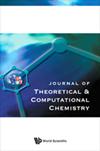Studies on the structure and conformational flexibility of secondary structures in amyloid beta — A quantum chemical study
IF 2.4
Q3 Computer Science
Journal of Theoretical & Computational Chemistry
Pub Date : 2020-09-01
DOI:10.1142/s0219633620500145
引用次数: 3
Abstract
Density functional theory (DFT) calculations are performed to study the conformational flexibility of secondary structures in amyloid beta (A[Formula: see text]) polypeptide. In DFT, M06-2X/6-31[Formula: see text]G(d, p) method is used to optimize the secondary structures of 2LFM and 2BEG in gas phase and in solution phase. Our calculations show that the secondary structures are energetically more stable in solution phase than in gas phase. This is due to the presence of strong solvent interaction with the secondary structures considered in this study. Among the backbone [Formula: see text] and [Formula: see text] dihedral angles, [Formula: see text] varies significantly in sheet structure. This is due to the absence of intermolecular hydrogen bond (H-bond) interactions in sheets considered in this study. Our calculations show that the conformational transition of helix/coil to sheet or vice-versa is due to the floppiness of the amino acid residues. This is observed from the Ramachandran map of the studied secondary structures. Further, it is noted that the intramolecular H-bond interactions play a significant role in the conformational transition of secondary structures of A[Formula: see text].淀粉样蛋白二级结构的结构和构象柔韧性研究-量子化学研究
进行密度泛函理论(DFT)计算以研究淀粉样蛋白β(A[公式:见正文])多肽中二级结构的构象灵活性。在DFT中,M06-2X/6-31[公式:见正文]G(d,p)方法用于优化2LFM和2BEG在气相和溶液相中的二次结构。我们的计算表明,二次结构在溶液相中比在气相中能量更稳定。这是由于存在与本研究中考虑的二级结构的强溶剂相互作用。在主干[公式:见正文]和[公式:见图正文]二面角中,[公式:参见正文]在片材结构中变化显著。这是由于本研究中考虑的片材中不存在分子间氢键(氢键)相互作用。我们的计算表明,螺旋/螺旋到片状或反之亦然的构象转变是由于氨基酸残基的漂浮性。这是从所研究的次级结构的Ramachandran图中观察到的。此外,值得注意的是,分子内氢键相互作用在a二级结构的构象转变中起着重要作用[式:见正文]。
本文章由计算机程序翻译,如有差异,请以英文原文为准。
求助全文
约1分钟内获得全文
求助全文
来源期刊
CiteScore
1.70
自引率
0.00%
发文量
0
审稿时长
3 months
期刊介绍:
The Journal of Theoretical and Computational Chemistry (JTCC) is an international interdisciplinary journal aimed at providing comprehensive coverage on the latest developments and applications of research in the ever-expanding field of theoretical and computational chemistry.
JTCC publishes regular articles and reviews on new methodology, software, web server and database developments. The applications of existing theoretical and computational methods which produce significant new insights into important problems are also welcomed. Papers reporting joint computational and experimental investigations are encouraged. The journal will not consider manuscripts reporting straightforward calculations of the properties of molecules with existing software packages without addressing a significant scientific problem.
Areas covered by the journal include molecular dynamics, computer-aided molecular design, modeling effects of mutation on stability and dynamics of macromolecules, quantum mechanics, statistical mechanics and other related topics.

 求助内容:
求助内容: 应助结果提醒方式:
应助结果提醒方式:


